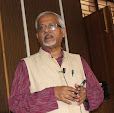SCRIBES MUST REPORT AS HUMAN BEINGS
Arindam Roy
Varanasi, February 26, 02
SUSAN Koscis, the vice president of Arts and Culture, of the International NGO, Search for Common Ground, quoted a line from a Work War II Musical, “You have got to be taught to hate and to fear,” to explain how conflicts and mistrusts are “Inherited’.
These become ‘educated biases’. The Musical, she explained, was set in South Pacific, describing the ‘torments’ of an American soldier, who fell in love with a girl from that island.
On the second day of her visit, she conducted a two-hour workshop on, ‘Media and Conflict Resolution’, at the Malaviya Centre for Peace Research (MCPR), the BHU, with the aid of video clip-pings. Dr Priyankar Upadhyaya, the convener of the center , had organized this interaction.
Recalling some reports of the Washington Post, she said one day there was a report that Palestinian terrorists had killed innocent people, the Israelis.
Next day, there was a report that Israeli soldiers, in order to protect themselves, had to open fire. Some innocent people, possibly a kid, died.
Thus, while the Palestinians were described as ‘terrorists’, similar acts by the Israeli soldiers were. ‘explainable’ and ‘logical’. The media in the US is liased in favour of Israel. It is not balanced or objective reporting, as it ‘influenced’ the views of the readers.
She said, some of the ‘operative’ words for journalists that help resolve conflicts are accurate, balanced; clarifies and raises consciousness; looks into the fundamental beliefs and issues; encourages diversity and exchange of ideas; provocative but non-judgmental; respects both sides, or as many sides there are, to a conflict, and sees the conflict in its totality.
Ms Koscis said that ’empowerment of people is central to resolving crisis, as it gives them a better understanding of their conflict. It is necessary for those caught in the ‘web of conflict’ to connect with each other as human beings.
She said, “I don’t know who heroes are. But hundreds of journalists in South Africa, the Balkans and Macedonia, on the other side of the conflict, and investigated the real facts, are certainly heroes.
==
SOLVING INTER-CASTE CONFLICTS
Arindam Roy
Varanasi, February 25, 02
MEDIA has an important role to play in solving inter-ethnic conflicts, said Susan Koscis, vice president of arts and culture of the leading international NGO, ‘Search for Common Ground’. She felt that socially conscious film makers help strengthen the influence of film and video in transforming conflicts.
In an exclusive interview to Hindustan Times, she said, the role of the journalists is not to transform the society directly, but to be accurate to provide the readers as much context as they can. They should be careful that the views of both sides in a conflict are presented to the readers.
Koscis said, “Try to be balanced. Journalists cannot be neutral but they should leave ‘bias’, as much as possible, out of the story. It is important to ‘respect’ the conflicting views”.
Talking about how her NGO helped resolve the conflicts between Macedonia and Albania, she said, a 10 day workshop of the journalists of Macedonia and Albania was organized. A prominent lady journalist of the Los Angeles Times, who know both, the languages, conducted this programme. She trained them in investigative journalism, of looking beyond what was being said by an official or a minister. The veracity of their claims had to be ‘tested’, rather than merely reporting their speech. It brought about a change in attitude.
The Macedonian and Albanian journalists teamed up together and explored the facts. New vistas opened up for them. Many of them, with their own initiative continued to do a lot of stories together. They understood each other better. These stories were published in Macedonian and Albanian newspapers. The people too got an Insight into the facts, which helped weed out lot of ‘misgivings’.
Her NGO is working in 10 odd countries. On the first day of her two-day visit to the city, two films were screened on Monday, in the Senate Hall of Swatantra Bhavan at BHU. The first film, ‘Just a Little Red Dot’, is a dramatization of a true story that occurred several years ago in Canada.
It explored the conflict of a young Sri Lankan girl, when she entered the fifth grade. She finds herself alienated in the new environment. Other children tease and taunt her, as she is a newcomer, who cannot speak English and wears a little red dot (Bindi) on her forehead. The film shows how children and their parents revert to prejudice and fear. A conflict is born.
The school teacher helps resolve the conflict. The Sri Lankan girl distributes little red dots to her classmates. Soon it becomes a ‘cool thing’. The situation is transformed. The barriers between the kids break down. She said, though the film made for children. It helped resolve the inter-ethnic conflict for adults, as these children took up the role of educating their elders.
The second film, ‘Long Night’s Journey’ is an award –wining documentary. It depicted South Africa’s struggle to come to terms with its Apart held past. Four stories help raise broader is sues about how the black and the white communities tried to heal their wounds. It is about building a new South Africa from the ruins of hatred.
=
Subscribe to:
Post Comments (Atom)












No comments:
Post a Comment